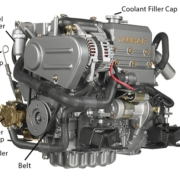Sailboat Diesel Engine Operation
As noted earlier, diesel engines are sturdy and highly reliable, and operating them today is straightforward. New diesel engines operate much like gasoline engines and the days of “glow plugs” (electric fuel warmers to heat the air before it passed into the combustion chamber) have passed into history.
There are usually very few problems associated with diesel engines.
- If an engine is turning over but not starting—it is probably a fuel problem.
- If it will not turn over—it is probably a battery issue.
- If it starts but stalls when shifting into gear—there is a line caught around the prop.
- If it is overheating—the freshwater pump is not working properly.

Diesel Engine Essentials
A few additional pointers:
- Unless you are operating in extreme cold conditions, diesel engines do not need a long warm-up. As soon as they are running smoothly after starting, they are good to go.
- Each diesel engine has its range of optimum rpm (rounds per minute). These operating conditions should be observed. Typically, you’ll find that 3000 rpm is the max short-term operating speed and 2500 is the max long-term operating speed.
- Engine noise is usually adequately muffled by soundproofing materials.
- On many vessels, the diesel throttle, whether in forward or reverse position, also engages the transmission. There is typically a button of some sort to pull next to the throttle/gear lever to disengage the gears whilst still throttling the engine. This is most often used to charge batteries or during the anchor windlass (winch) operation.
One symptom that may require professional help is a smoking diesel engine. This may be due to a wide variety of causes, including overfilling the oil receptacle, faulty injectors, or corrosion.
The reason for these somewhat detailed explanations is to ensure proper attention is given to maintaining your diesel engine. It is a vessel’s primary source of power for getting in and out of slips, for providing essential electronic services and creature comforts, and most importantly, in emergency situations.
Here is a simple but essential prestart checklist:
- Diesel fuel tank level
- Engine oil level between the min and max on the dipstick
- Fuel filter
- Water filter
- Coolant water
- Belts
- Engine pan—no collection of oil or fluids
- Hoses
Lastly, we leave you with this: Avoid stowing the keys to the engine in someone’s pocket. If that person goes overboard, you’ve got problems.







